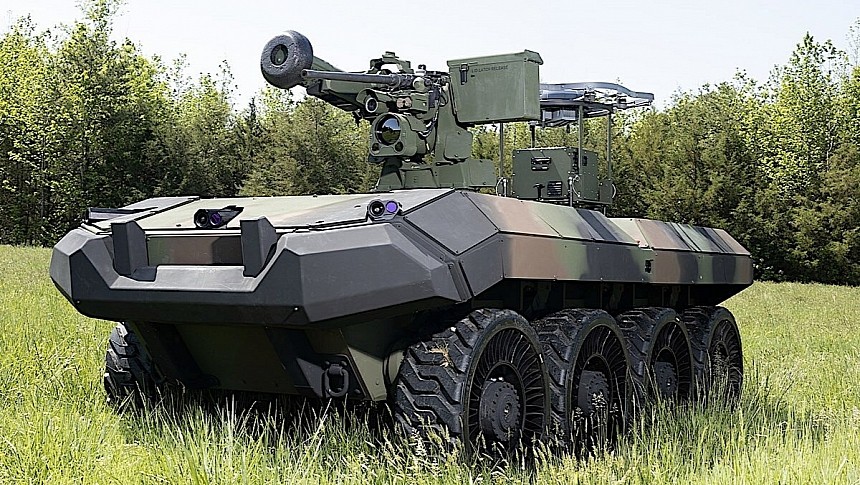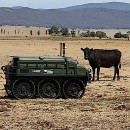At the end of last month the U.S. Army announced the names of the companies that will try to make its future robotic combat vehicle (RCV). I'm talking about an uncrewed platform capable of carrying a variety of payloads on the battlefield to assist soldiers in their missions.
Four companies are battling for what will eventually turn into a contract, namely Textron Systems, McQ, General Dynamics Land Systems, and Oshkosh Defense. All will have to come up with vehicle prototypes by the summer of next year.
We've already had a first look at what Textron Systems has to offer, the Ripsaw M3, but an idea of what the Army plans to use in the future can't be accurately formed if we didn't look at all of the proposals. Today's treat: the Wolf-X.
This robotic combat vehicle is the work of a company called HDT. It will be put together in RCV configuration by HDT under the guidance of McQ and with help from BAE Systems.
Unlike the Ripsaw, which comes with tracks, the Wolf-X uses wheels, eight of them, to move about its business. Just like the Textron solution, it also comes as a platform that can be adapted for a variety of tasks, from carrying cargo to acting as a base for weapons.
The full details on the Wolf-X have not been released, but we do know it is based on another HDT product called Hunter Wolf. That one was meant to support light infantry and can carry up to 2,200 pounds (almost 1,000 kg) of cargo on a variety of hard terrain, including narrow trails, slopes, and dense jungle.
Compared to the 8-wheeled Wolf-X, the Hunter is a 6x6, powered by a hybrid or electric powertrain that allows it to move for up to 200 km (124 miles).
The RCV variant of the HDT machine will be small enough to allow its transportation inside a Boeing CH-47 Chinook. It will be fully capable of supporting weapons as large as an MK44 30mm chain gun and the armor it needs to protect itself from enemy fire.
It's not clear at this point what will power the robot's autonomous functions and how it will be remotely controlled. HDT does say the robot has been "engineered to accommodate future growth requirements," meaning that if accepted by the Army, it may be around for a very long time.
Once a prototype version of the vehicle is ready, it will be delivered to the U.S. Army for testing. The military branch is expected to start the second phase of the RCV program in 2025, and announce the contract winner then. We should see these machines in active duty sometime in 2028.
We've already had a first look at what Textron Systems has to offer, the Ripsaw M3, but an idea of what the Army plans to use in the future can't be accurately formed if we didn't look at all of the proposals. Today's treat: the Wolf-X.
This robotic combat vehicle is the work of a company called HDT. It will be put together in RCV configuration by HDT under the guidance of McQ and with help from BAE Systems.
Unlike the Ripsaw, which comes with tracks, the Wolf-X uses wheels, eight of them, to move about its business. Just like the Textron solution, it also comes as a platform that can be adapted for a variety of tasks, from carrying cargo to acting as a base for weapons.
The full details on the Wolf-X have not been released, but we do know it is based on another HDT product called Hunter Wolf. That one was meant to support light infantry and can carry up to 2,200 pounds (almost 1,000 kg) of cargo on a variety of hard terrain, including narrow trails, slopes, and dense jungle.
Compared to the 8-wheeled Wolf-X, the Hunter is a 6x6, powered by a hybrid or electric powertrain that allows it to move for up to 200 km (124 miles).
The RCV variant of the HDT machine will be small enough to allow its transportation inside a Boeing CH-47 Chinook. It will be fully capable of supporting weapons as large as an MK44 30mm chain gun and the armor it needs to protect itself from enemy fire.
It's not clear at this point what will power the robot's autonomous functions and how it will be remotely controlled. HDT does say the robot has been "engineered to accommodate future growth requirements," meaning that if accepted by the Army, it may be around for a very long time.
Once a prototype version of the vehicle is ready, it will be delivered to the U.S. Army for testing. The military branch is expected to start the second phase of the RCV program in 2025, and announce the contract winner then. We should see these machines in active duty sometime in 2028.







